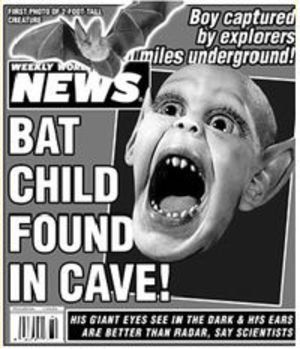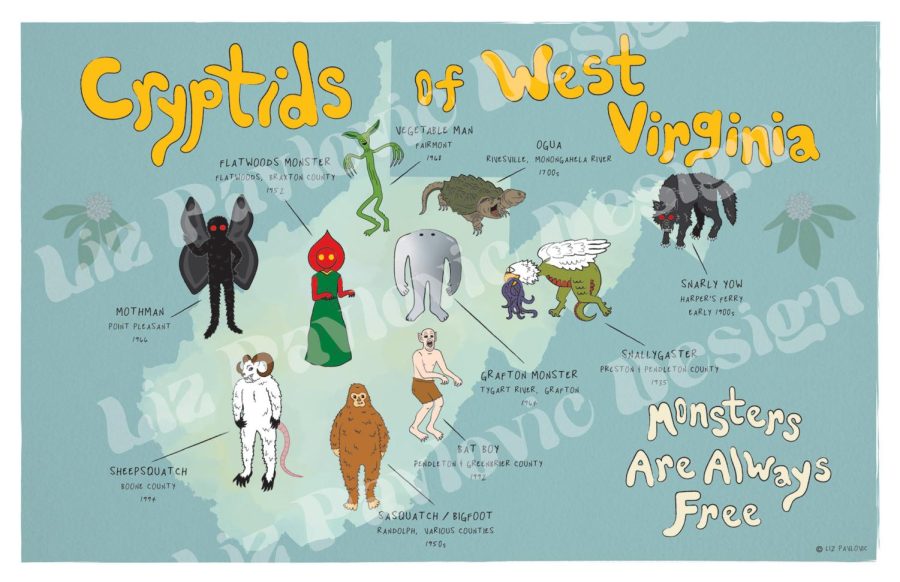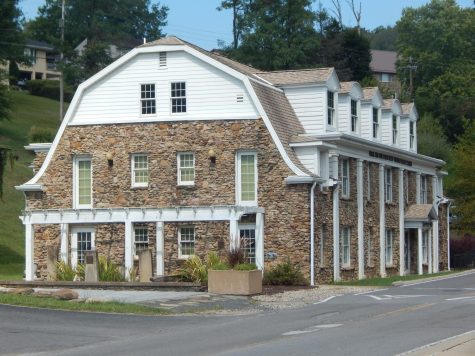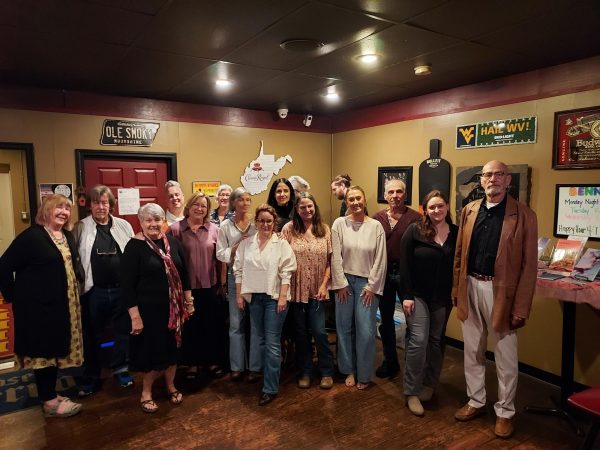The Wild, Wonderful, and Weird of West Virginia: Craziest Cryptids
This is the third and final article about West Virginia cryptids. In this final installation, I will review some crazier cryptids: Bat Boy, Sheepsquatch, the Snarly Yow, and the Snallygaster. If you have not already read my previous two articles and you are interested in learning about West Virginia folklore and cryptids, then I highly recommend them. In the first article, I talked about the Ogua, the Vegetable Man (A.K.A. Veggieman), and the Grafton Monster, which can be read here. In the second article, I reviewed some of the more infamous cryptids, Mothman and the Flatwoods Monster, and you can read it here.

The first cryptid on the list is not your typical West Virginia cryptid. His story is not that of an alleged sighting turned folk legend like most of the others, but instead that of a trashy tabloid headline. On June 23, 1992, the supermarket tabloid Weekly World News ran the first story on the cryptid Bat Boy. On the front page, the issue ran the headlines “Bat child found in cave!” and “Boy captured by explorers 2 miles underground! His giant eyes see in the dark & his ears are better than radar!” These captions were accompanied by a photograph of a half-human, half-bat creature snarling with its fangs exposed next to the quote: “For the last time … I said no autographs!”
When he was ten years old, Bat Boy was supposedly discovered in Hellhole Cave in Pendleton County, West Virginia. The human-bat hybrid was said to be the offspring of a human woman named Susan Boy and spent his early life underground, secluded from the world. The scientists who reportedly discovered the creature took it upon themselves to introduce him to the world.
Weekly World News had exclusive updates on Bat Boy as he grew up and traveled the world. Over the years, he reportedly got up to some whacky stuff, like biting Santa Claus, joining the Army, having a secret relationship with Jennifer Lopez, running for governor of California, and so much more.
In 1997, Bat Boy became the subject of an off-Broadway horror rock musical, “Bat Boy: The Musical,” written by Keythe Farley and Brian Flemming, with music and lyrics by Laurence O’Keefe.
As the years went on, Weekly World News slowly stopped running articles on the crazy creature and he faded into obscurity, leaving many to wonder what has happened to him. Maybe one day, there will be a new update or a sighting of the international celebrity Bat Boy.
The next cryptid is particularly hairy and gained popularity because of the local legend Ruth Ann Musick. Sheepsquatch is reported to be about the size of a bear, with long, white, wool-like fur, saber-like teeth, a long snout, and horns. It is a quadruped, whose forelimbs are described as ending in paw-like hands, like a raccoon, but it has a long and hairless tail like an opossum. It is reported to be carnivorous and dangerous.
Folklorist Ruth Ann Musick first documented Sheepsquatch in her 1965 book “The Telltale Lilac Bush and Other West Virginia Ghost Tales,” a collection of 100 folklore and ghost stories. According to that account, the Sheepsquatch was first spotted in Kanawha County, possibly in the eastern end of its range, near the low hills and ridges of the lower Kanawha River region.
Since the release of the book, Sheepsquatch has been spotted many times. The cryptid made its rounds in West Virginia, with reports of the creature being spotted in Mason, Putnam, Kanawha, and especially Boone County in the 1990s.
Sheepsquatch was spotted twice in 1994. It was first spotted in the woods by a former Navy seaman, who said the creature knelt to drink from the creek and then ran off into some brush. Then, two kids spotted it in Boone County and said it looked like a white bear and, when it stood up on its hind legs, was over six feet tall. The children startled the beast, and it ran off through the woods, breaking tree limbs in its path.
In 1995, the creature was spotted by a couple driving through Boone County, sitting in the ditch along the road. They stopped the car to get a better look when they saw the large white creature with horns. The creature turned around, and they saw it had four eyes. Unlike previous accounts, the creature did not run away. Instead, it lept out of the ditch and started to attack the car. The couple drove off and later noticed large scratches on the side of the car from the attack.
Then, in 1999, in Boone County, a couple of campers were in the forest at night around a bonfire when they heard an animal snorting and scuffling around the camp like an aggravated bear, but they couldn’t see anything in the darkness. Suddenly, Sheepsquatch lunged out of the darkness at the campers. The campers ran back into their house while Sheepsquatch chased after them. They watched as the white thing stopped at the edge of the forest and let out a terrible scream before turning around and heading back into the woods. When the campers returned to their campsite the next morning to collect their things, they found all their stuff torn up.
One of the most recent sightings of the cryptid actually comes from 2015 in Fulks Run, Virginia. Deep in the forests of Appalachia, six campers were spending the night when they spotted the beast around midnight. One of the campers saw the beast at the top of the nearby hill, in a crouching position, when it suddenly stood up and started running down the steep hill toward the campers. The camper alerted the others but wasn’t too worried as the flowing river separated them. The campers were horrified when the creature got to the river and searched for a way to cross before it decided to wade through the water after them. The campers say the creature was 8-9 feet tall with a shoulder length of 4-5 feet. Coming out of the river soaking wet on its hind legs towards the campers, it suddenly stopped when there was a loud screech from the distance. Then, the creature looked up, and his moonlit face looked scared as it let out a whimper and then sprinted off into the woods. The campers immediately packed up, left, and told the locals about their encounter.
Let’s hope that you never come across this unpredictable creature in the woods and that if you do, something scarier spooks it away, or you can run faster than it.
Our last two cryptids, the Snarly Yow and the Snallygaster, both “appeared” in Appalachia around the same time, in the 1700s, when many German immigrants settled in the Potomac River valley and in parts of Pennsylvania. Both cryptids are mostly a part of Maryland folklore, especially in the western part of the state. Still, they have been known to make their rounds in West Virginia and are generally interesting to learn about.
The Snarly Yow is described as being a phantom, dog-like creature. It is usually reported as having jet-black fur, large paws, glowing eyes, and a red snarling mouth. The cryptid is labeled as a phantom because of its ability to appear and disappear into thin air, change its size, and be able to survive being shot and run over. Don’t worry because this cryptid seems only to haunt old roadways in small towns and challenge travelers that try to cross its path, but it doesn’t hurt them.
The cryptid’s name is from Germanic words that describe its wail and because of the way it shows its teeth. There are many folk legends around the world of ghostly black dogs and even mysterious black cats, especially in the British Isles. It is not unlikely that the Snarly Yow is derived from that same folklore as immigrants moved and settled around the world.
Over the past few hundred years, there have been many reports of people in the tri-state area seeing a massive black dog with glowing eyes and a red, snarling mouth along roadways stopping travelers on horses and in cars. The Snarly Yow has mostly been spotted around the Blue Ridge Mountains and South Mountain in Maryland but has been seen roaming the mountains near Harpers Ferry, the Blue Ridge Mountains, and the Shenandoah River valley in the Eastern Panhandle of West Virginia, as well as in Hillsboro, Virginia.
Although the Snarly Yow has never been reported as hurting anyone, there have been many reports of people who encountered the creature and tried their best to kill it and failed. Those who have tried to shoot the phantom dog have watched their bullets pass through its body without causing harm or drawing blood.
Most reports of the Snarly Yow sightings happened during the Civil War, from 1861 to 1865 (West Virginia was still a part of Virginia until 1863). The Civil War was a not-so-civil” war, with about 620,000 deaths in less than five years. There have been many reports of ghost sightings at Civil War battle sites, with people seeing men in Confederate and Union uniforms marching along the hills seemingly made of vapor. There have been reports of phantom gunshots and screaming at night.
Although, during the actual battles of the Civil War, there weren’t reports of dead soldiers haunting the battlefields. Instead, the Snarly Yow did. The Snarly Yow was often seen at the Civil War battle site in Turner’s Gap battle of South Mountain, Maryland, in September 1862. Several witnesses reported seeing the creature at Turner’s Gap along Route 40. The reports claim that the beast would stop whoever dared travel along that road.
The Snarly Yow was seen so many times during the Civil War that there is a Civil War historical marker in Boonsboro, Maryland, with a side note about the cryptid that reads: “Beware of the Snarly Yow.”
Legend has it that the shadow of a black dog used to prowl the heights of South Mountain. One night, a huntsman, famous as a sure shot, encountered the beast. He aimed and fired his rifle. The shot went right through the animal with no effect. He fired again and again, each shot passing through the shadowy beast. Finally overcome with dread, the huntsman fled.”
After the Civil War, reports of the creature dwindled until almost 200 years later. During the 1970s, there was a resurgence in reports of the Snarly Yow, especially amongst motorists who reported a large dog that would suddenly appear in front of their cars and then disappear after they hit it or drove through the dog. In 1976, a couple in Frederick County, Maryland, reported hitting a large, black dog with glowing eyes that vanished when they stopped to check on it. Another motorist near Boonsboro, Maryland, claimed to have run over the monster, only to see it standing and raging defiantly in his rearview mirror afterward.
Another report from the 1970s detailed that a person who became startled by the giant black dog began throwing rocks and sticks at it to scare it off, but instead, they passed through its body. The dog then snarled at the person before disappearing. Others have reported seeing the phantom beast walk through objects in its way.
If you ever come across a large black dog with glowing eyes along a back road at night, it’s probably best to keep driving and not look back.
The Snallygaster, or as I like to call it, the Snarly Yow’s ugly cousin, is also more of a Maryland cryptid. Still, this German creature has been reported to make its way across the border into West Virginia occasionally. The earliest accounts of the Snallygaster terrorizing the German settlers refer to it as a Schneller Geist, which means “quick spirit” in German.
The Snallygaster is described as a half-reptile, half-bird, chimera-like creature. It reportedly has giant wings, a metallic beak lined with razor-sharp teeth, and sometimes tentacles like an octopus. According to folklore, the cryptid would swoop in and pick up its victim before carrying them away to suck its blood. It was said that the beast didn’t like stars with seven points, and the stars were painted on barns to keep the beast away, and the stars are still painted on barns in the area to this day.
There are claims that the legend of this beast was revived and told to freed slaves in the mid-1800s, around the time of the civil war, to scare them out of leaving.
In 1909, there was a resurgence in the story of the Snallygaster when multiple newspaper reports were published in February and March 1909 detailing scary encounters between local residents and a beast with “enormous wings, a long-pointed bill, claws like steel hooks, and an eye in the center of its forehead,” that made screeching sounds “like a locomotive whistle.” The Middletown’s Valley Register, a weekly newspaper, published multiple articles regarding the terrifying creature and its whereabouts for a few months.
On February 12, 1909, The Middletown Valley Register released its first front-page headline on the Snallygaster, reporting that the flying cryptid had been spotted in New Jersey, West Virginia, and Ohio, with there even being footprints of the beast in the snow in New Jersey. The stories were published until March 1909, when it was revealed that the sightings were fake.
All of the reports of the Snallygaster sightings started with a man named Thomas C. Harbaugh of Casstown, Ohio, when he wrote a letter to the Valley Register in early 1909. In his letter, he talked about a strange beast that flew over him, making terrible screeching noises, and mentioned that it was headed in their direction. He described the creature as having two huge wings, a large horny head, and a twenty-foot-long tail.
However, it was revealed that Harbaugh was born and raised in Middletown, Maryland, and was a friend of George C. Rhoderick, the publisher, and editor of the Middletown Valley Register. Harbaugh would write letters under various pseudonyms and under his own name to the Middletown Valley Register and some other local newspapers to help bring attention to the newspaper. Rhoderick, Harbaugh, and journalist Ralph S. Wolf were all in cahoots to help boost newspaper sales. They had seen how well the story of the Jersey Devil’s visit to New Jersey in January 1909 did, so in early February 1909, reports started coming in saying that people had seen the Snallygaster flying monster in Frederick County. The Cumberland Evening Times reported the first sighting of the cryptid in Middletown, as they also decided to capitalize on the tale of the Snallygaster.
This fake news strategy was so successful that it allegedly caught the attention of the 26th President, Theodore Roosevelt, an avid hunter, and naturist. It is said that the President was ready to delay his hunting trip to Africa so that he could go hunt the beast until he learned that the newspaper story was fake. Legend also states that the Smithsonian Institution offered a $100,000 reward for anyone who could capture the creature.
There are a lot of whacky urban legends and conspiracy theories about Theodore Roosevelt, especially involving cryptids. There are many stories about Theodore Roosevelt hunting for Bigfoot and other cryptids. There are even stories that he shot Bigfoot! There are conspiracy theories that he was in huge support of conserving land and starting the National Park Service because he wanted to find cryptids. People believe that the government would say they sent people to survey the land and create trails when they were searching for monsters in the national and state parks. It should be noted that these are strictly urban legends and should not be taken as truth or fact. They are fun little stories and should not be used to spread misinformation, especially regarding the National Park Service and the Smithsonian Institution.
This cryptid has been around for centuries and has gained more notoriety in recent years. In 2008, a book titled “Snallygaster: The Lost Legend of Frederick County” was published by Patrick Boyton, detailing the lore of the cryptid and the creature’s foe, the Dewayo. Then, in 2021, a museum for the cryptid called The American Snallygaster Museum was opened in Libertytown, Maryland, by the self-proclaimed cryptozoologist Sarah Cooper.
Suppose you are interested in learning more about West Virginian and Appalachian folklore. In that case, I highly suggest contacting the Frank and Jane Gabor West Virginia Folklife Center here on campus, where Ruth Ann Musick lived before she died and now allegedly haunts. You can also go to the Ruth Ann Musick Library, here on campus, where we have copies of her books and other collections of folklore.








